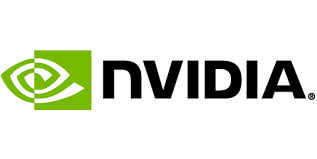 nVidia RIVA TNT2 Series (1999)
nVidia RIVA TNT2 Series (1999)
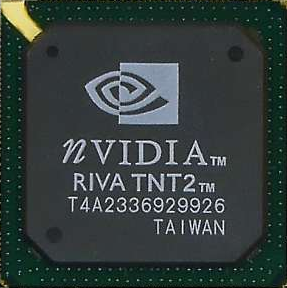
nVidia RIVA TNT2 (1999)
Summary
| Launched | March 1999 |
VESA Support | Yes, VESA VBE 3.0 and DDC2B |
| Bus Type | AGP 2x or 4x | API Support | DirectX 6.0 and OpenGL 1.2 |
| Chipset | NV5 | Found on Cards | Hercules Dynamite TNT LeadTek WinFast 3D S325 ELSA Synergy II-32 ELSA Erazor III LT G Gigabyte GA-660 STB Velocity 4400 Creative 3D Blaster Riva TNT2 Ultra Asus AGP-V3800 Deluxe Diamond Viper V770 Ultra Hercules Dynamite TNT2 Ultra AOpen PA3020 Guillemot Maxi Gamer Cougar |
| Core Clock | 150 MHz | ||
| Memory | 16 or 32 MB | ||
| Memory Speed | 125 - 235 MHz | ||
| RAMDAC | (integrated) | Competitors | 3Dfx Voodoo2 3Dfx Voodoo3 ATI Rage 128 Matrox Millennium G400 S3 Savage4 |
| RAMDAC Speed | 300 MHz |
Introduction
While the original RIVA TNT failed to outperform its main competitor, 3dfx Voodoo2 in raw performance, it surpassed it when it came to image quality. This led to a key decision for avid gamers in 1997 and 1998, where you needed to opt for one over the other based on your preference - best performance or best image quality (though TNT also had some issues with its image quality). nVidia knew their next chip needed to be the best at both.
Their 5th-generation 2D/3D graphics accelerator chipset, TNT2 (NV5), was introduced at the Game Developers Conference in March 1999 . Like its forebear, it had dual 3D pixel pipelines onboard but added a number of critical features including AGP 4x support, up to 32 MB of VRAM, 32-bit Z-buffer support, and 2048 x 2048 texture sizes.
Built on TSMC's new 250 nm (nanometre) manufacturing process, this enabled the NV5 die to run at lower chip temperatures allowing internal clock speeds to be increased massively. The core clock ran as standard at 150 MHz, up from TNT's 90 MHz, while its integrated RAMDAC now ran at 300 MHz over the TNT's rated maximum of 250 MHz. Memory now clocked in at 150 MHz as standard (previously only possible on the TNT through overclocking). All of this meant the TNT2 could process 250 MPixel/sec and 9 million triangles/sec - a roughly 25% performance increase over the standard TNT. Memory throughput was an impressive 2.4 GB/sec. According to nVidia, TNT2 was optimised for the Pentium III and AMD K6-2/K6-3 with 3dNow! technology, though the drivers that would include 3D Now! optimisations wouldn't arrive until a bit later.
The TNT2's memory architecture was identical to that of the TNT with its 128-bit memory pipeline. However, maximum video memory was now raised to 32 MB of onboard SDRAM, allowing for 2D applications to run at up to 2046 x 1536 resolution at a 32-bit colour depth / 60 Hz vertical refresh rate.
TNT2's support for the latest 3D APIs remained unchanged over the TNT - with Microsoft DirectX 6.0 and full support for OpenGL 1.2. This was still the latest and greatest in 1999.
Its main competitor again came from the 3Dfx camp with their Voodoo3, which launched in same month as TNT2. This first model Voodoo3 1000 ran at a core clock of 125 MHz, but 3Dfx released two faster variants just one month later with the Voodoo3 2000 which came with core and memory clocks of 143 MHz and the Voodoo3 3000 which ran at 166 MHz for both. Voodoo3's 3D image quality was still behind that of nVidia's, with its maximum texture size of 256 x 256 pixels.
Unlike with the original TNT, the various graphics card vendors (Diamond, ASUS, Canopus, Guillemot, and Hercules) who were due to implement the RIVA TNT2 were openly invited to set their own core and memory clocks for their own designs. While none of them veered to far off the recommended baseline from nVidia, their Windows Control Panel and other utilities catered for overclocking both core and memory independently.
Alongside the TNT2's launch were two alternative model variants: a budget-oriented variant called Vanta, which came with a reduced core clock of 100 MHz along with either 8 MB or 16 MB of SDRAM memory running at 125 MHz (880 MB/sec). It also got a slower 250 MHz RAMDAC. Vanta was able to display up to 1920 x 1200 in 32-bit colour depths at a 72 Hz refresh rate.
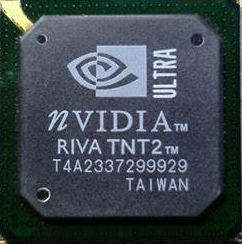 The second model was the top-performing TNT2 Ultra, which came with a 150 MHz core clock and 183 MHz memory clock (2.9 GB/sec). This pushed its 3D processing throughput up to 300 MPixel/sec - a 20% improvement over the standard TNT2 and a 50% improvement over the TNT.
The second model was the top-performing TNT2 Ultra, which came with a 150 MHz core clock and 183 MHz memory clock (2.9 GB/sec). This pushed its 3D processing throughput up to 300 MPixel/sec - a 20% improvement over the standard TNT2 and a 50% improvement over the TNT.
In October 1999, nVidia launched two more model variants to the TNT2 line-up. The TNT2 Pro, which came with a 143 MHz core clock speed and 166 MHz memory speed as standard. This gave the Pro a 286 MPixel/sec throughput (14% faster than the standard TNT2 but 5% slower than the Ultra) with memory throughput of 2.65 GB/sec. The second was the TNT2 M64 - essentially the same as the original TNT2, but with a 64-bit memory interface which halved the memory throughput capability to 1.1 GB/sec.
A year after the first TNT2's arrival Vanta LT was released as their bulk-budget offering with just 8 MB of SDRAM, further-reduced clocks of 80 and 100 MHz for core/memory respectively. The Vanta LT's slower memory speed meant its throughput was only 800 MB/sec. Both Vanta and Vanta LT were hugely popular with OEMs due to their low cost and "reasonable" 2D and 3D performance.
Both M64- and Vanta-based cards are best avoided if you're looking to play late 90s games.
Here's a comparison of the RIVA TNT2 with some of its competitors, 3Dfx Voodoo3 1000, 3Dfx Voodoo3 3000, and ATI Rage 128 Pro:
| RIVA TNT2 | 3Dfx Voodoo3 1000 | 3Dfx Voodoo3 3000 | ATI Rage 128 Pro | |
|---|---|---|---|---|
| Release Date | March 1999 | March 1999 | April 1999 | August 1999 |
| Chip | NV5 | Avenger | Avenger | ? |
| Bus | AGP 4x | PCI or AGP 2x | PCI or AGP 2x | AGP 4x |
| Core Clock | 125 MHz | 125 MHz | 166 MHz | 125 MHz |
| Memory Sizes | 16 or 32 MB SDRAM | 16 MB SRAM (PCI) or SGRAM (AGP) | 16 MB SDRAM (PCI) or SGRAM (AGP) | 16 MB SDRAM |
| Memory pipeline | 128-bit | 128-bit | 128-bit | 64-bit |
| Memory Clock | 125 - 235 MHz | 125 MHz | 166 MHz | 143 MHz |
| Memory Bandwidth | 2.4 GB/sec | 2.29 GB/sec | 2.6 GB/sec | 2.08 GB/sec |
| RAMDAC | 300 MHz | 300 MHz | 350 MHz | 300 MHz |
| # Pixel Shaders | 2 | 1 | 1 | 2 |
| # Vertex Shaders | 0 | 0 | 0 | 0 |
| # Texture Mapping Units (TMUs) | 2 | 2 | 2 | 2 |
| # Raster Operation Pipelines (ROPs) | 2 | 1 | 1 | 2 |
In manufacturing the RIVA TNT2 chip, nVidia continued their relationship with TSMC (Taiwan Semiconductor Manufacturing Company), using their 250 nm manufacturing process for their March 1999 releases: TNT2, TNT2 Ultra and Vanta (Vanta LT also used this process). For the later October 1999 release of the TNT2 Pro, they used the updated 220 nm manufacturing process.
3D Jargon Busting in 1998
Bump mapping - to bring textured surfaces into relief, bump mapping changes their colours and shadows, depending on the intensity and direction of the light hitting the surface.Edge anti-aliasing smooths the edges of triangles by calculating lines between vertices.
Per-pixel anti-aliasing, also known as sort-independent or scene anti-aliasing, artifically expands the resolution of a scene in the frame buffer memory, performs an averaging operation, and then resamples to the correct resolution. The result is a smoother image.
Triple buffering increases the number of frames drawn per second. As one scene is being rendered in the front buffer of the graphics card, the next two scenes are sent to two back buffers for processing.
Trilinear MIP mapping - In 3D space, textures are applied to surfaces using tiny bitmapped files. Trilinear MIP mapping adjusts the level of detail visible in each textured surface, depending on that surface's distance from the viewer.
Z-buffering stores the Z (or depth) value of each pixel and then compares it with other pixels in the same area of the screen. The greater the bit depth, the more precise the indication of depth in 3D space; 24-bit Z-buffering provides 24 distinct levels of depth in each pixel, where 32-bit Z-buffering provides 32.
The RIVA TNT2 had the same solid set of 3D features as the TNT: Alpha-Blending, Anisotropic Filtering, Anti-Aliasing, Bilinear and Trilinear Filtering, Bump Mapping, Environment Mapping, Fogging, Gouraud Shading, Hardware Triangle Setup, MIP Mapping, Perspective Correction, Specular Highlights, Subpixel Precision, 10GFLOP Floating Point Geometry, 32-bit Texture Mapping and Transparency. TNT2 now also got 32-bit Z-Buffering and a 32 MB frame buffer.
With the TNT2 the performance hit when running in 32-bit texture modes was much lower, though still noticeable compared to running in 16-bit textures.
The nVidia RIVA TNT2 series all support DirectX 6.0 and OpenGL 1.2 via Installable Client Drivers (ICDs). Drivers were made available for Windows 95 and 98, Windows 2000 and Windows NT 4.0.
Supported Graphics Modes
32 MB RIVA TNT2 cards support 2D resolutions up to 2048 x 1536 in True-Color mode.
For 3D graphics, 32 MB cards max out at 1600 x 1200 with a 32-bit colour depth and 32-bit Z-buffer. Compare this to Voodoo3's absolute maximum of 1024 x 768 with a 16-bit colour depth (it cannot support 24- or 32-bit colour).
The table below outlines the TNT2's vertical refresh rates available at each resolution:
32 MB 2D Display Modes & Refresh Rates
|
TNT2 / Pro / Ultra 3D Display Modes
|
Memory
Architecturally not a lot changed on the RIVA TNT2 compared to the RIVA TNT, with both having support for SDRAM and the faster SGRAM memory and both implemented a 128-bit memory pathway. Most Standard and Pro RIVA TNT2 cards did come with double the memory (32 MB) compared to TNT cards, though a few provided only 16 MB. The budget-oriented RIVA TNT2 M64 got the same core capabilities of the standard chip but ran a 64-bit memory pathway. Cards based on the M64 came in either 8, 16, or 32 MB flavours.
The SGRAM-based cards weren't as overclockable on the memory clock side of things compared to the SDRAM ones, but the performance gains of going with SGRAM more than made up for this.
Ports
Most RIVA TNT2 cards only got the standard 15-pin DSUB monitor connector, though a few, like some flavours of the Creative Labs 3D Graphics Blaster TNT2 and ELSA Erazor III Pro also got an S-Video out port. The ELSA Erazor III Pro also came with a DVI output for LCD screens. ASUS also had a full complement of video-out and video-in ports on their V3800/TV/TVR/TVR Deluxe, depending on which variant you purchased. Many of the Ultra cards also came with an S-Video out port.
Switches
The nVidia RIVA TNT2 series are fully Plug & Play, so no hardware configuration / jumpers / DIP switches need to be set.... with one exception. The Diamond Viper V770 has a couple of jumpers on the board to switch between AGP 2x and AGP 4x. By default these cards came from the factory configured for AGP 2x, since in March 1999 AGP 2x was still the norm in everyone's PC (the first motherboards to support AGP 4x were those based on Intel's i820 and VIA Apollo Pro 133A, which both arrived in early 2000).
Upgrades and Successors
The RIVA TNT2 was succeeded October 1999 (when its later TNT2 variants arrived) with the introduction of the GeForce 256 (NV10). It initially only came out with SDR (Single Data Rate) memory running at 166 MHz, but in December they released a DDR (Double Data Rate) variant with a 150 MHz memory clock. These both used AGP 4x like the TNT2 and ran at a reduced core clock of 120 MHz. The key advantage of the NV10 was its 4 pixel pipelines though it kept the single texture unit of the TNT2. With double the pipelines, the card's fillrate was almost double that of the TNT2. In terms of clock speeds, the GeForce256 SDR can be thought of as a TNT2 Pro with double the pixel pipelines, while the GeForce256 DDR is closer to the original TNT2 but with double the pixel pipelines. This move to DDR memory made all the difference though, with about an 80% increase in memory throughput over the SDR variant despite running with slower clocks.
Reception
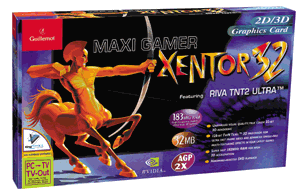 As TNT2 cards came onto the market in March 1999, Diamond Multimedia launched the Diamond Viper V770 in AGP 4x only form, and could be overclocked to a healthy 175/200 core/memory speed via their included "InControl Tools 99". Creative Labs were also one of the first with the 3D Graphics Blaster TNT2 (CT5823), as were Guillemot with the Maxi Gamer Xentor 32. These cards came with a price tag of between $130 and $200. For the Ultra cards, the price point was higher, typically around $230.
As TNT2 cards came onto the market in March 1999, Diamond Multimedia launched the Diamond Viper V770 in AGP 4x only form, and could be overclocked to a healthy 175/200 core/memory speed via their included "InControl Tools 99". Creative Labs were also one of the first with the 3D Graphics Blaster TNT2 (CT5823), as were Guillemot with the Maxi Gamer Xentor 32. These cards came with a price tag of between $130 and $200. For the Ultra cards, the price point was higher, typically around $230.
The RIVA TNT2 cards went head to head with the 3Dfx Voodoo3, with mixed results in reviews. As with the TNT which competed with the Voodoo2, nVidia's offering provided for better image quality but was just slightly behind 3Dfx in terms of raw 3D performance. The much larger texture sizes would be leveraged much later than the release date of March 1999, so if you bought a TNT2 card upon launch it was difficult to realise its full potential, though it was leaps ahead of the Voodoo2. TNT2s did overclock well, however, helping to close the gap with the faster cards in the Voodoo3 range.
The table below is a summary of the various TNT2-based cards that were released, ordered by variant. The core and memory clocks specified here are the defaults set by the card's vendor:
| Make/Model | Variant | Bus | Memory Size | Core Clock | Memory Clock |
|---|---|---|---|---|---|
| Creative Labs 3D Graphics Blaster TNT2 (CT5823) | TNT2 | AGP 4x | 32 MB SDRAM | 125 | 150 |
| ELSA Synergy II-32 | TNT2 | PCI | 32 MB SDRAM | 125 | 150 |
| Diamond Viper V770 | TNT2 | AGP 4x | 32 MB SDRAM | 125 | 150 |
| Cardex CARDEXpert TNT2 | TNT2 | AGP 4x | 32 MB SGRAM | 125 | 150 |
| Leadtek WinFast 3D S320-II-16 | TNT2 | AGP 4x | 16 MB SDRAM | 140 | 165 |
| Leadtek WinFast 3D S320-II-32 | TNT2 | AGP 4x | 32 MB SGRAM | 140 | 150 |
| MSI 3D AGPhantom TNT2 (MS8806) | TNT2 | AGP 4x | 32 MB SGRAM | 125 | 150 |
| PowerColor SNiper 2 | TNT2 | AGP 4x | 32 MB SGRAM | 125 | 150 |
| ASUS V3800 Ultra | TNT2 Ultra | AGP 4x | 32 MB SGRAM | 150 | 183 |
| Creative Labs 3D Graphics Blaster TNT2 Ultra (CT6810) | TNT2 Ultra | AGP 2x | 32 MB | ? | ? |
| Creative Labs CT6870 | TNT2 Ultra | AGP 4x | 32 MB SGRAM | 150 | 183 |
| Guillemot Maxi Gamer Xentor 32 | TNT2 Ultra | AGP 4x | 32 MB SDRAM | 175 | 183 |
| Hercules Dynamite TNT2 Ultra | TNT2 Ultra | AGP 4x | 32 MB SDRAM | 175 | 200 |
| Innovision Tornado TNT2 Ultra | TNT2 Ultra | AGP 4x | 32 MB SDRAM | 150 | 183 |
| Canopus Spectra 5400 | TNT2 Ultra | AGP 4x | 32 MB SDRAM | 150 | 183 |
| ELSA Erazor III Pro | TNT2 Pro | AGP 4x | 16 MB SGRAM | 143 | 166 |
| Leadtek WinFast LRI2811 | TNT2 Pro | AGP 4x | 32 MB | ? | ? |
| HIS TNT Pro AGP | TNT2 Pro | AGP 4x | 32 MB | ? | ? |
| ASUS V3800M | TNT2 M64 | AGP 4x | 32 MB SDRAM | 125 | 150 |
| Palit Daytona | TNT2 M64 | PCI | 32 MB SDRAM | 125 | 150 |
| Creative Labs 3D Blaster TNT2 M64 (CT6890) | TNT2 M64 | AGP 4x | 16 MB SDRAM | 125 | 150 |
| Creative Labs 3D Blaster TNT2 M64 (CT6980) | TNT2 M64 | AGP 4x | 32 MB SDRAM | 125 | 150 |
| Guillemot Maxi Gamer Cougar | TNT2 M64 | AGP 4x / PCI | 16 MB SDRAM | 125 | 150 |
| MSI MS8807 | TNT2 M64 | AGP 4x | 8 MB SDRAM | 125 | 150 |
| MSI TNT2 M64 (MS8808) | TNT2 M64 | AGP 4x | 16 MB SDRAM | 125 | 150 |
| Leadtek LR2137 | TNT2 M64 | AGP 4x | 16 MB SDRAM | 125 | 150 |
| Leadtek LR2138 | TNT2 M64 | AGP 4x | 32 MB SDRAM | 125 | 150 |
| Leadtek LR2816 | TNT2 M64 | AGP 4x | 16 MB SDRAM | 125 | 150 |
| PowerColor SNiper M (CM64A) | TNT2 M64 | AGP 4x | 16 MB SDRAM | 125 | 150 |
| Sparkle SP5200B | TNT2 M64 | AGP 4x | 32 MB SDRAM | 125 | 150 |
| Mercury / Holtek KOB N620 | TNT2 M64 | AGP 4x | 32 MB SDRAM | 125 | 150 |
| VisionTek G7500 | TNT2-M64 | AGP 4x | 8 MB SDRAM | 125 | 150 |
| VisionTek NV996 | TNT2-M64 | AGP 4x | 32 MB SDRAM | 125 | 150 |
| EVGA e-TNT2 M64 | TNT2-M64 | AGP | 16 MB SDRAM | 125 | 125 |
| Fastware AGP-RIXI M101 | Vanta | AGP 4x | 16 MB SDRAM | 125 | 150 |
| Innovision Tornado TNT2 Vanta | Vanta | AGP 2x | 16 MB SDRAM | 100 | 110 |
| Aztech Vanta-8 | Vanta | AGP 4x | 8 MB SDRAM | ? | ? |
| Aztech Vanta-16 / Vanta-16T | Vanta | AGP 4x | 16 MB SDRAM | ? | ? |
| IBM FRU 25P4058 | Vanta | AGP 4x | 16 MB SDRAM | ? | ? |
| Octek AVNTB1-16M | Vanta | AGP 4x | 16 MB SDRAM | 100 | 125 |
| Gigabyte GA-620-16C | Vanta | AGP 4x | 16 MB SDRAM | 100 | 125 |
| Pine Technology PV-T04B-A2 | Vanta | AGP 4x | 16 MB SDRAM | 100 | 125 |
| Compaq Vanta-16 | Vanta | AGP 4x | 16 MB SDRAM | 100 | 125 |
| ELSA Erazor III LT A32 | Vanta LT | AGP 4x | 16 MB SDRAM | 105 | 100 |
| Topsearch TS-M-8VOC | Vanta LT | AGP 4x | 8 MB SDRAM | 105 | 100 |
| Compaq Vanta LT 8MB | Vanta LT | AGP 4x | 8 MB SDRAM | 105 | 100 |
Gateway 2000, IBM, Compaq and Dell were just a few of the major OEMs who bought up TNT2 M64s and Vantas for their PCs.
The best RIVA TNT2 cards, unsurprisingly, came from ASUS, with their V3800 series. These came with highly-rated 200 MHz SGRAM memory, and if you wanted composite or S-video out or video-in capabilities they offered those too. TV-out was handled via a Chrontel 7003B-V chip which is regarded as slightly better than the equivalent Brooktree 869. All models apart from the base one also came bundled with ASUS' own stereoscopic VR3D glasses. The non-"Ultra" V3800 variants ran with a core/memory of 125/150 MHz respectively. Anandtech managed to overclock the core to 150 MHz with ease, but they commented that SGRAM isn't designed to be particularly overclockable - still, they got the memory up to 160 MHz stable. The utility software allowed for core/memory overclocking as well as enabling or disabling VSync.
The Diamond Viper V770 was on par with the ASUS V3800 performance-wise when it came to the stock TNT2 cards.
The fastest TNT2s were of course the TNT2 Ultra ones. Specifically the Hercules Dynamite TNT2 Ultra came out of the box with a core/memory clock of 175/200, with the runner up being the Guillemot Maxi Gamer Xentor 32, which was configured for 175/183. These days if you're in the market for a TNT2, I would certainly recommend one of these two. Understandably, Ultra cards do run hotter than the non-Ultra ones, and Anandtech noted specifically that the Creative and Diamond Ultra cards were the hottest. Of the standard TNT cards, the Leadteks and Hercules ran the hottest.
S3's Savage4 and Savage4 Pro chips were their primary offerings in the running in 1999, though as usual, these were considered budget cards. The Savage 4 clocked both core and memory at 125 MHz while the Pro ran its core at 143 MHz. Cards that used the Savage4 Pro came with 32 MB of SDRAM, but most Savage4 non-Pro cards came with just 8 MB. Despite these numbers being in the same ballpark as the TNT2, the chip itself just wasn't comparable. So what did the S3 cards have going for them? Price! At just £69 retail, they suited those with shallow pockets.
Matrox's G400 was their latest offering of 1999 at the time of the TNT2's launch. Like the TNT2, the G400 could handle 32-bit rendering as well as having 32-bit Z-buffer support, and true to Matrox's reputation the quality of output was incredible. However, the same story we've heard before was to be repeated - it could not produce the frame rates of the new TNT2 or the 3Dfx Voodoo3. With the Matrox Tweak Utility, released in 1999, you could overclock the core and memory from their defaults of 125 MHz and 166 MHz respectively, and enable/disable VSync.
Since many games in 1999 did not require more than 16 MB of texture memory, opting for a 32 MB TNT2 really didn't any value (the Voodoo3 came with 16 MB total, and was still the [slightly] better of the two in raw performance in most games). The other value-add of AGP 4x with the TNT2 was also a bit a misnomer - yes, it supported it, but nobody's PC could run AGP 4x, and even when new motherboards that did provide AGP 4x functionality in their chipsets, the performance difference between AGP 2x and 4x was negligible.
Images
The cards shown in this section illustrate the various models of card with a variety of memory and BIOS ICs. There are too many variants and vendors to list them all, so I've focussed on just the main original TNT2 ones.
Creative Labs CT5823 (RIVA TNT2 AGP 4x 32 MB SDRAM):
ELSA Synergy II-32 (RIVA TNT2 PCI 32 MB SGRAM):
Diamond Viper V770 (RIVA TNT2 AGP 4x 32 MB SDRAM):
Leadtek WinFast 3D S320-II-16 (RIVA TNT2 AGP 4x 16 MB SDRAM):
Leadtek WinFast 3D S320-II-32 (RIVA TNT2 AGP 4x 32 MB SGRAM):
The Leadtek WinFast 3D S320-II cards came in both SDRAM and SGRAM versions. The software drivers provided with the Leadtek cards include an overclocking utility that allows tweaking of both core and memory clock speeds in 1 MHz increments, up to 160 MHz for the core and 175 MHz for the memory. You can also switch VSync on and off.
MSI 3D AGPhantom TNT2 (MS8806) (RIVA TNT2 AGP 4x 32 MB SGRAM):
ASUS V3800 Ultra (RIVA TNT2 AGP 4x 32 MB SGRAM):
The ASUS cards comes in several variants:
V3800 [Basic]: 15-pin VGA connector only.
V3800 TV: VGA + TV-out
V3800 TVR: VGA + TV-out + Video-in + ASUS Virtual Reality 3D circuit + video capture.
V3800 TVR Deluxe: VGA with TNT2 Ultra Graphic Engine + TV-out + Video-in+ ASUS Virtual Reality 3D Glasses + video capture
All variants got 32 MB of SGRAM. Only the V3800 TVR Deluxe got the TNT2 Ultra chip which ran at 150/183 MHz (core/memory) - the others all ran at 125/150 (core/memory).
Downloads
RIVA TNT2 drivers are called Detonator or Forceware, and come in two forms: (1) reference drivers developed and released by nVidia themselves, and (2) manufacturer-specific drivers for their own cards. Up to around Detonator v4.12.01.0367 the drivers were available for PCI and AGP cards separately, but from v4.12.01.0368 these were merged into a single driver download set. Even if these later ones are marked as 'AGP' they will still work on your PCI card. Early version of Detonator are often referred to just by their minor version number at the end, e.g. 4.12.01.0367 was just called v3.67.
The RIVA TNT2 was the last series of cards from nVidia to support Windows 3.1.
Windows 95 drivers, at least for the AGP version of the card, require OSR 2.1 to be installed.
Windows NT 4.0 drivers require Service Pack 3 to be installed.
Bear in mind the early drivers from nVidia were not yet optimised for AMD's 3DNow! technology - these would arrive shortly after launch in 1999. nVidia also tended to optimise their latest drivers for the current latest hardware, so a newer driver is often *not* the right thing to use if you have an older CPU or card - download one that is very period-correct according to when your CPU became the premium option on a PC. For example, Detonator reference driver v2.08 provides much better performance than v7.76.
Most vendors' custom Control Panel advanced settings include the option to enable or disable VSYNC. VSYNC is the synchronization of all buffer swaps to the refresh rate of your monitor, theoretically limiting the attainable frame rate by the refresh rate your monitor is set at. Disabling it will improve performance but may degrade visual quality by introducing "tearing".
Most vendors' Control Panels allow you to overclock the card dynamically, but if your particular RIVA TNT2 card's driver does not provide overclocking options under the Control Panel applet, you can use PowerStrip which is a third-party utility.
Click on an icon in the table below to download the file.
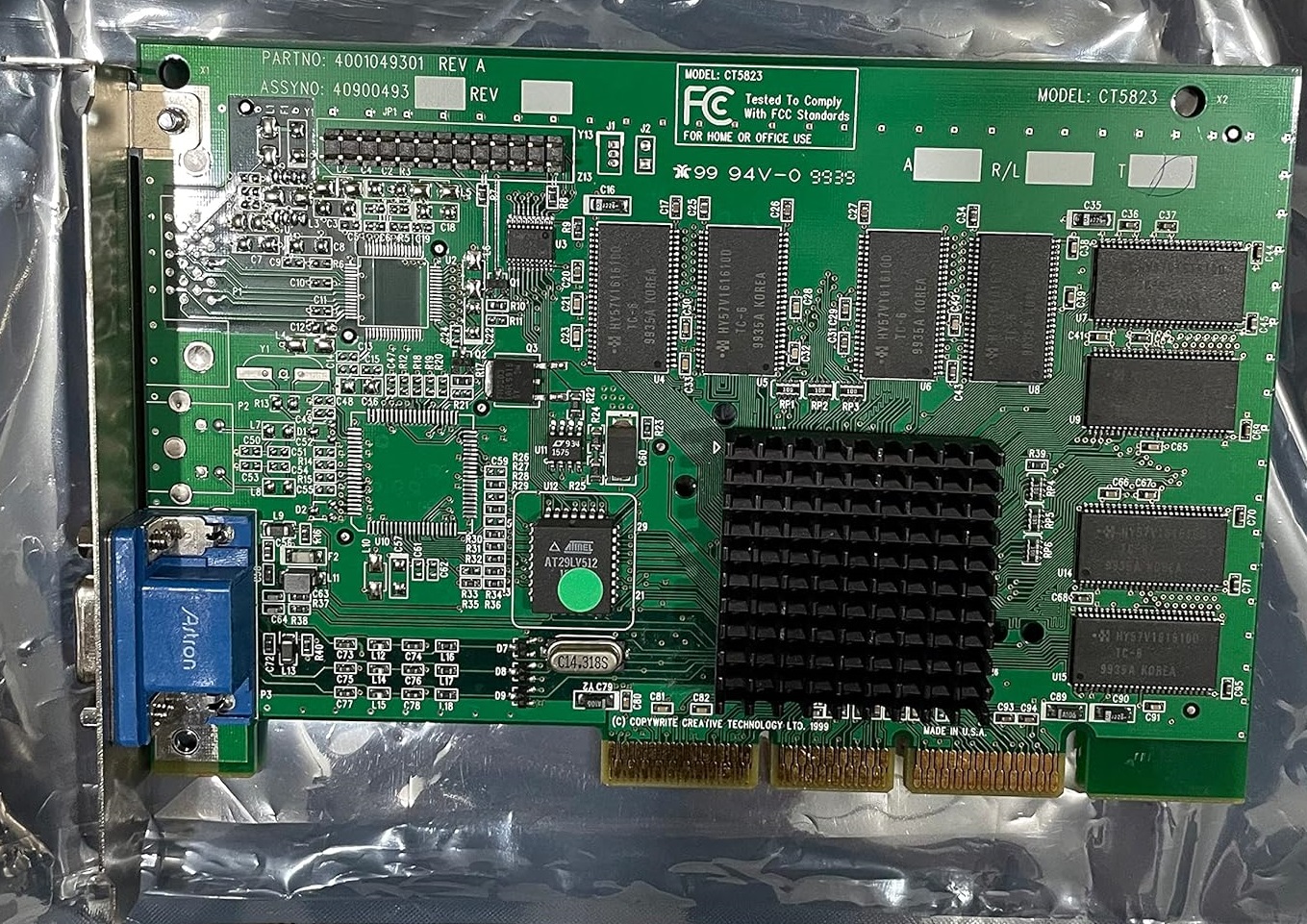


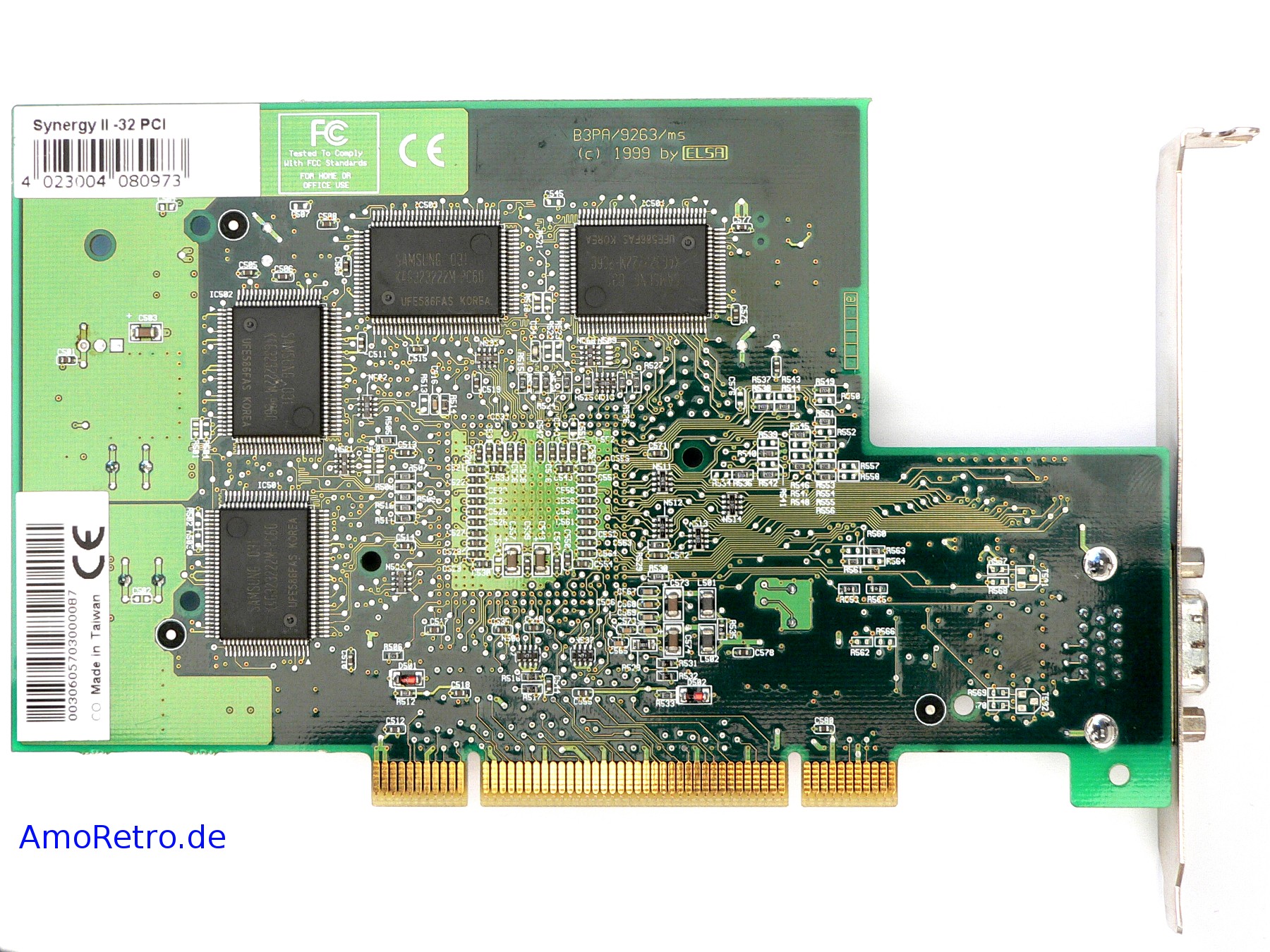
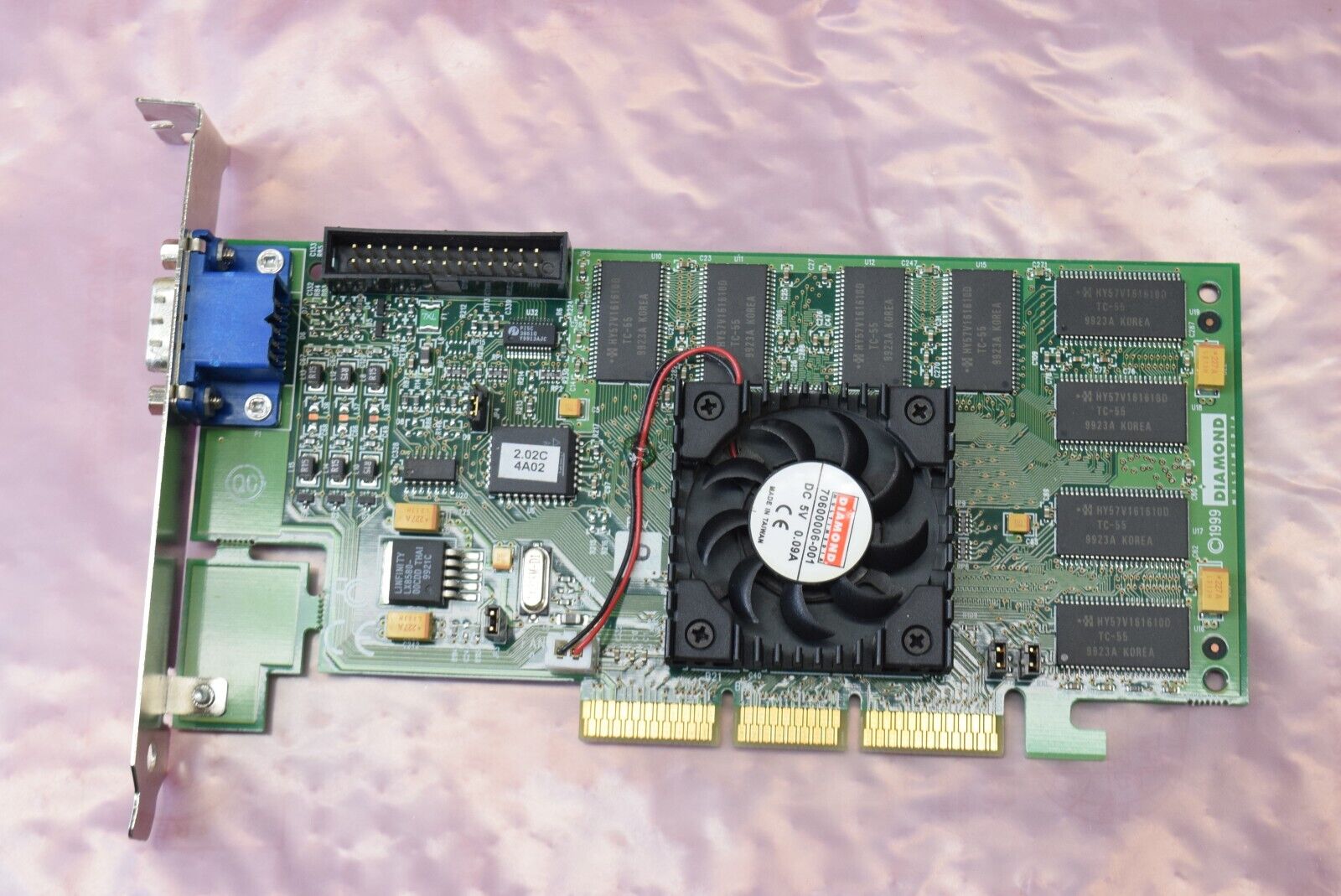
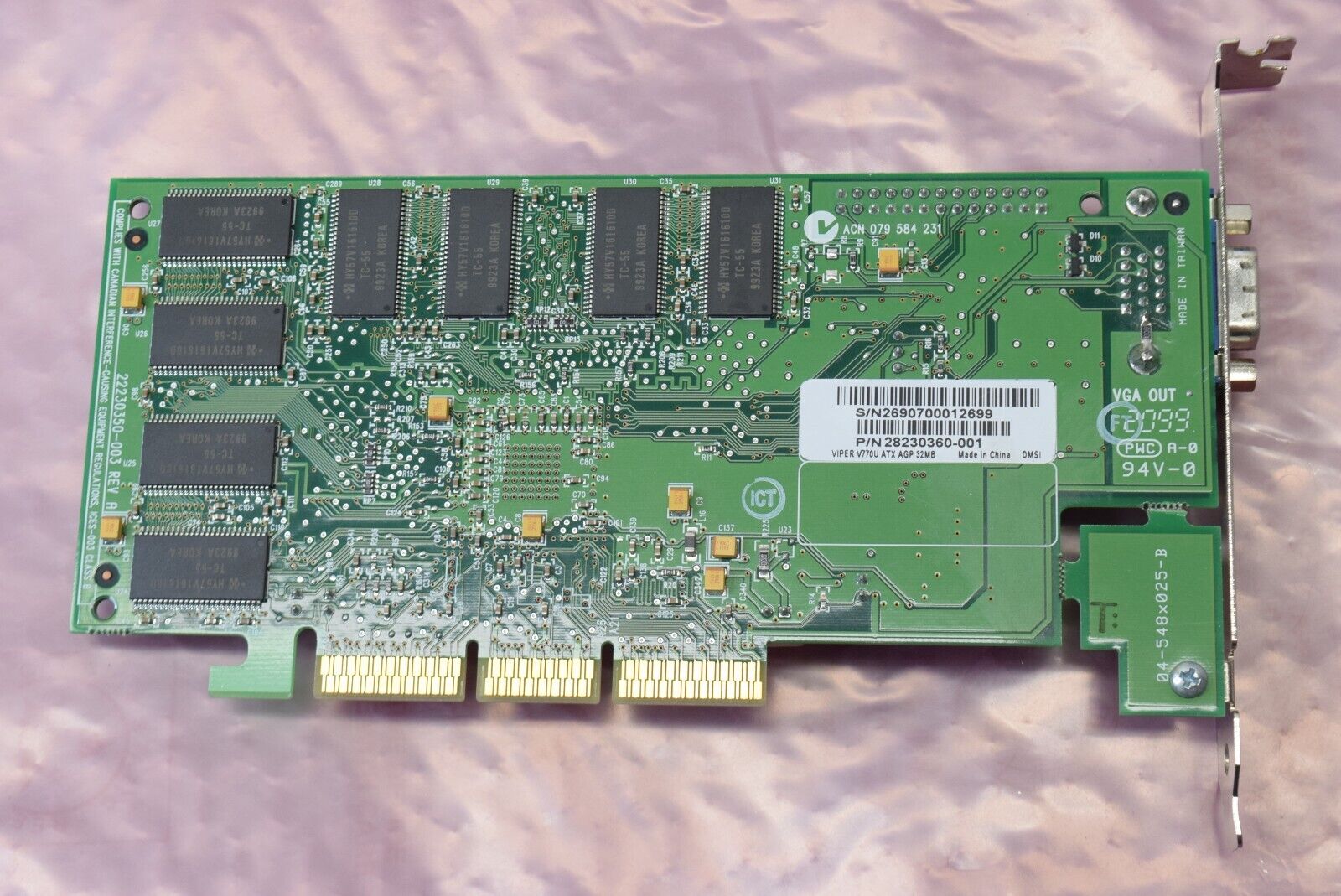
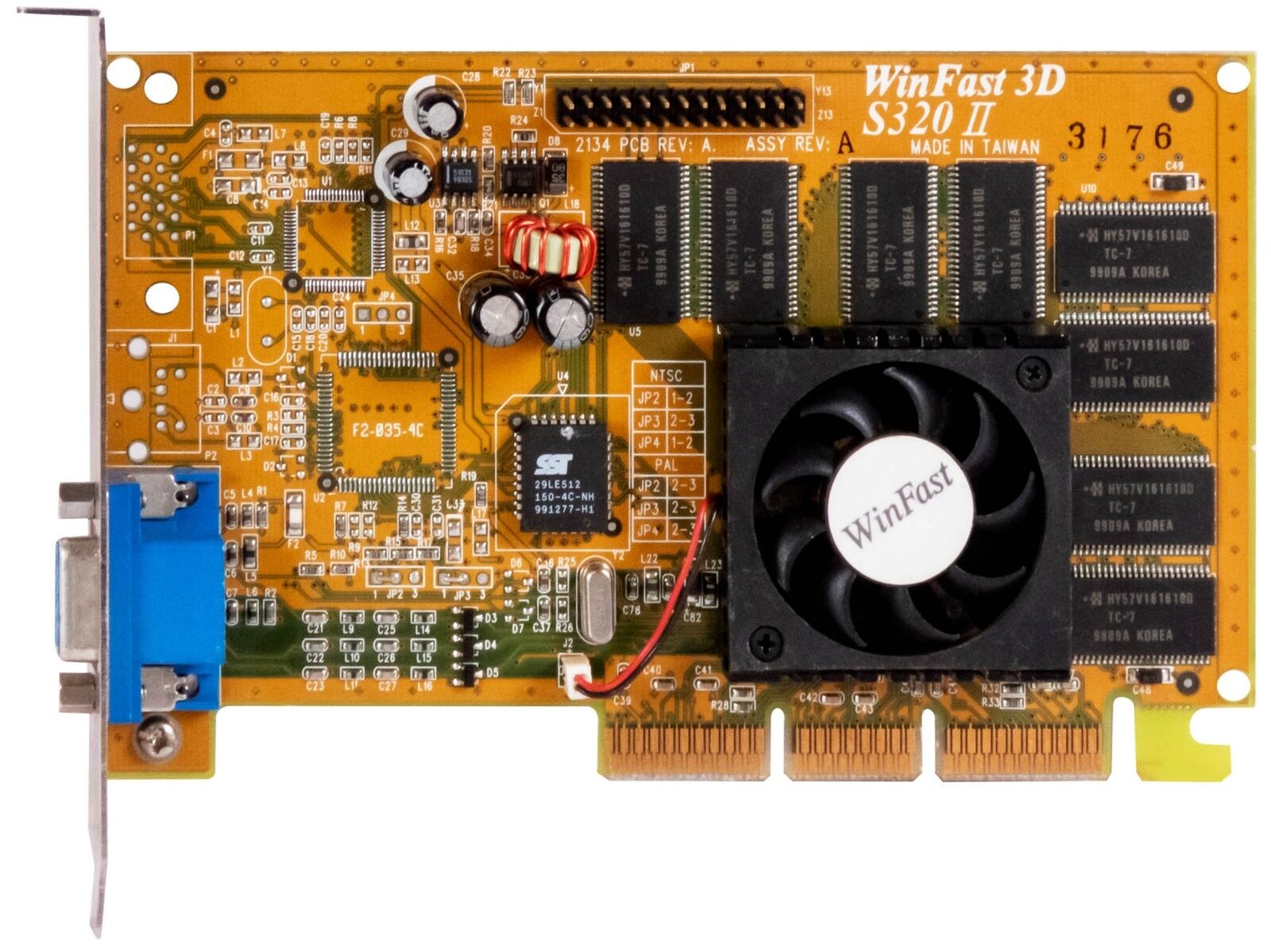
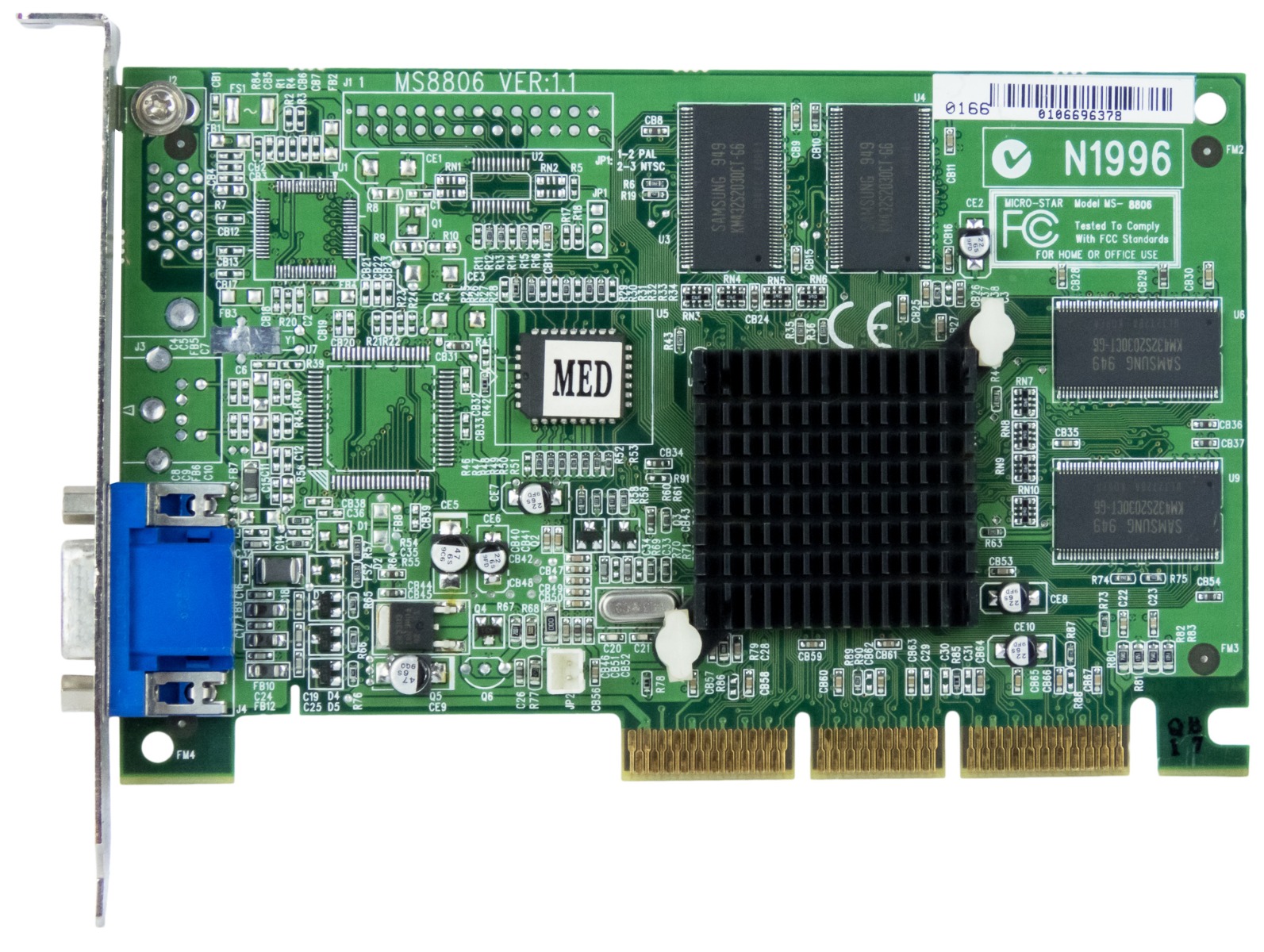

 Windows 95/98 Detonator Reference PCI Driver
Windows 95/98 Detonator Reference PCI Driver